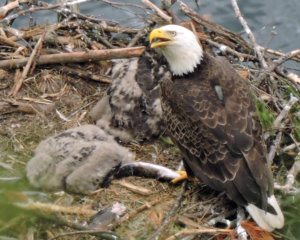Out Doors: The eagles have landed

Eagles have landed in the Champlain Valley. Eggs have hatched and fuzzy young eaglets populate local nests. With patience and a good pair of binoculars it’s possible to see the buff-colored mounds of fluff moving around the huge piles of sticks they call home.
For much of the past century, hunting, habitat loss and widespread use of DDT took a huge toll on the bald eagle population. DDT slows calcium metabolism causing reproductive failure (weak egg shells) in bald eagles. Biologists estimate that there may have been as many as 100,000 bald eagles in the lower 48 states before Europeans arrived. By the early 1960s fewer than 100 were nesting in the northeastern United States.
In recent decades these giant birds have been reintroduced. Audubon Vermont and Vermont Fish and Wildlife record 21 territorial pairs in Vermont, a number of which are at or near the edge of Lake Champlain.
The bald eagle is big. Its wingspan can extend to 90 inches, and it stands more than 30 inches tall. The blackish eagle sports a white head and tail and a long yellow bill. The eagle can be a powerful predator but also will feed on carrion, including dead fish washed ashore. It will steal food from ospreys and other birds. Its primary diet is fish, but eagles will also eat birds, small mammals, turtles, crabs and shellfish.
The eagle’s nest is a massive pile of sticks usually high in a tree near the water and occasionally on top of a cliff. For good hunting the eagle needs a wide field of view; nests frequently tower above neighboring trees. The tree must be sturdy—white pines are a preferred species in this region—and the nest can be as high as 180 feet above the ground. Nests are lined with finer materials and can be reused and added to for many years, becoming enormous. Great horned owls sometimes take over nests.
Eagles first breed at age four or five and may mate for life. In spring an eagle lays two or three white eggs that both parents will incubate for 34 to 36 days. The Audubon Guide to North American Birds says, “At least one parent remains with young almost constantly for first two weeks. Both parents bring prey to nest, tearing food into small pieces and feeding it directly to young at first; after three to six weeks, young begin pecking at food dropped in nest. In seasons when prey is scarce, only largest young may survive.” Age at first flight is about 10–12 weeks. Eaglets are terrifically camouflaged from above (against predation), as can be seen in the accompanying photos.
Where might you see an eagle’s nest? The road leading to Kingsland Bay State Park in Ferrisburgh, Hawkins Road, has a nest set back from the road above a large field. The home tree—a cottonwood if my memory serves me—is very close to Little Otter Creek. On a recent visit a man with a bird-spotting scope was able to see one eaglet head. The field is marked with “keep out” signs to protect the eagles. They also serve to identify the location. Dead Creek Wildlife Management Area in Addison is another place to look. It’s easier to see nests from the water. A paddler or boater often knows a nest is nearby because screeching parents will warn off trespassers.
Is the recovery of eagles likely to continue in the Champlain Valley? Bald eagles are extremely susceptible to lead poisoning, and eating fish that have swallowed leaded hooks, lines or sinkers, remains an ongoing threat to our national bird—as does the recent relaxation of rules governing lead shot by President Trump.
So, don’t use lead. Grab your binoculars instead, and get outdoors to look for eagles!

